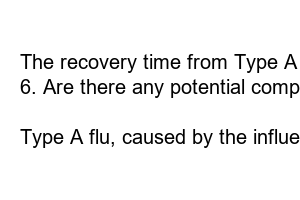A형독감
Title: Understanding Type A Flu: Symptoms, Prevention, and Treatment
Subheadings:
1. What is Type A Flu?
2. Symptoms of Type A Flu
3. Prevention and Precautions
4. Treatment Options for Type A Flu
5. Frequently Asked Questions (FAQs)
What is Type A Flu?
Type A flu is a contagious respiratory illness caused by the influenza A virus. It is one of the most common flu strains and can cause mild to severe illness, leading to hospitalizations and even death in some cases. Type A flu viruses are highly adaptable, constantly mutating, and causing regular seasonal outbreaks.
Symptoms of Type A Flu
The symptoms of Type A flu are similar to those of other flu strains. They include fever, cough, sore throat, body aches, fatigue, runny or stuffy nose, headache, chills, and sometimes even vomiting or diarrhea. These symptoms usually appear suddenly and can last for several days or more.
Prevention and Precautions
To minimize the risk of contracting Type A flu, it is critical to follow a few preventive measures. Frequent handwashing is essential, especially before eating or touching your face. *Avoid close contact* with individuals who are sick, and if you’re feeling unwell, it is highly recommended to stay home and rest. *Getting vaccinated against Type A flu* is another effective way to protect yourself and prevent the spread of the virus.
Treatment Options for Type A Flu
If you develop symptoms of Type A flu, it is important to rest, stay hydrated, and take over-the-counter pain relievers to alleviate discomfort. *Antiviral medications* may also be prescribed by your healthcare provider to reduce the severity and duration of the illness. These medications work best if taken within the first 48 hours of symptom onset.
Frequently Asked Questions (FAQs)
1. How is Type A flu different from Type B flu?
Type A flu is known to cause more severe illness and is responsible for large-scale outbreaks, including pandemics. On the other hand, Type B flu tends to cause milder illness and typically occurs in smaller, localized outbreaks.
2. Who is at higher risk of developing complications from Type A flu?
Certain populations are at a higher risk of developing severe complications from Type A flu, including young children, older adults, pregnant women, individuals with weakened immune systems, and those with underlying medical conditions.
3. Is the Type A flu vaccine effective?
Yes, getting vaccinated against Type A flu is highly effective in preventing infection or reducing the severity of the illness if you do contract the virus. The flu vaccine is updated annually to address the predominant flu strains for the upcoming flu season.
4. Can you get Type A flu more than once?
Unfortunately, yes. Since Type A flu viruses are constantly changing and new strains circulate every year, it is possible to contract Type A flu multiple times throughout your life.
5. How long does it take to recover from Type A flu?
The recovery time from Type A flu varies from person to person. Generally, it takes about one to two weeks to fully recover from the illness. However, in severe cases, it may take longer for the body to regain its strength.
6. Are there any potential complications from Type A flu?
Yes, Type A flu can lead to complications such as pneumonia, bronchitis, sinus infections, and worsening of pre-existing medical conditions. It is crucial to seek medical attention if you experience difficulty breathing, persistent cough, chest pain, or a high fever that lasts for more than a few days.
Summary:
Type A flu, caused by the influenza A virus, is a highly contagious respiratory illness that can cause mild to severe symptoms. Prevention through good hygiene practices and vaccination is key in reducing the risk of contracting the virus. Early treatment and rest help in a faster recovery. Stay informed, take precautions, and prioritize your health during flu season to keep yourself and your loved ones safe.

